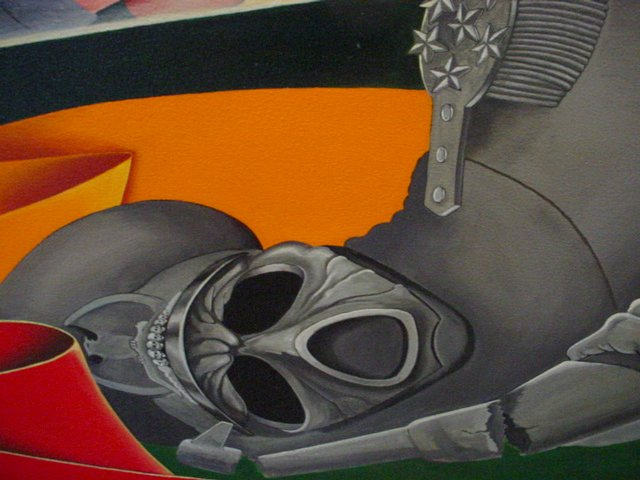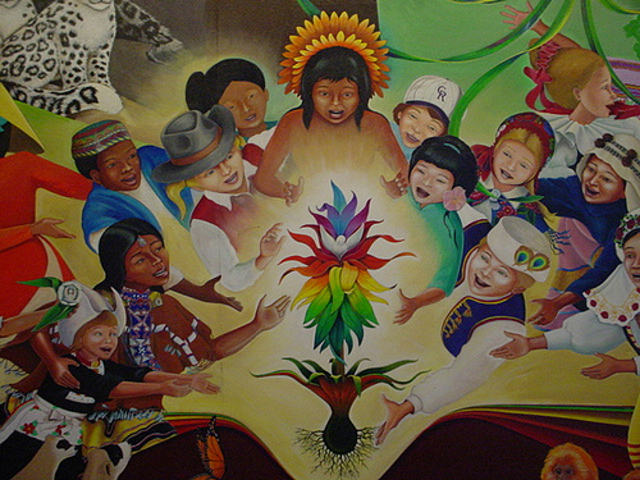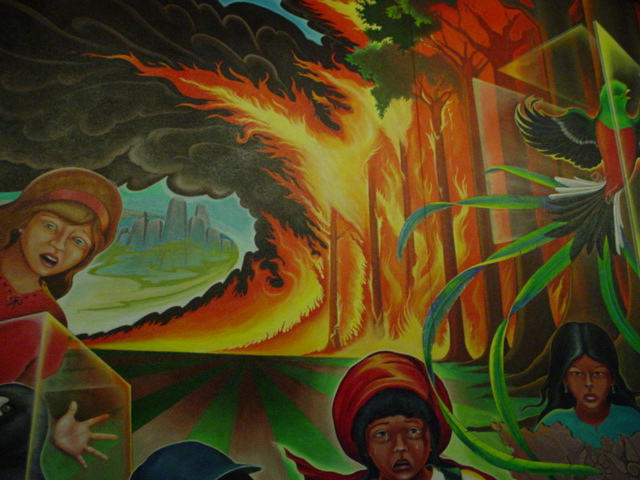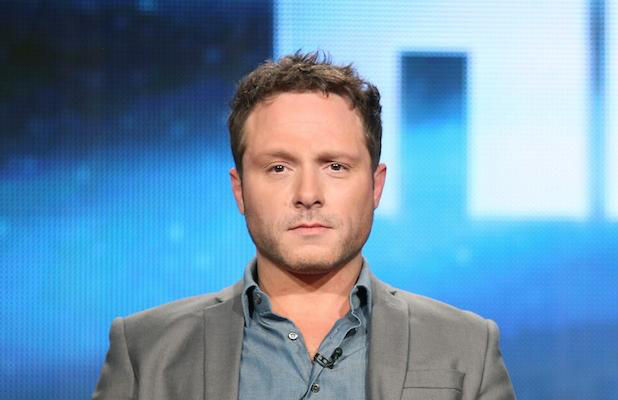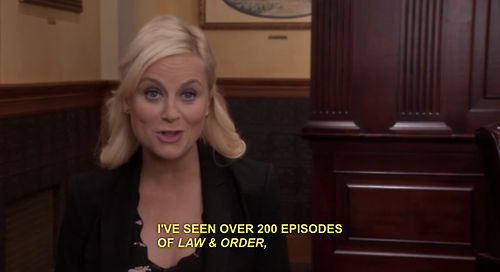What’s Next For True Detective? Definitely Nothing Weird, That’s For Sure!
Just the "secret occult history of the United States transportation system." (Also: what happened at the end?)
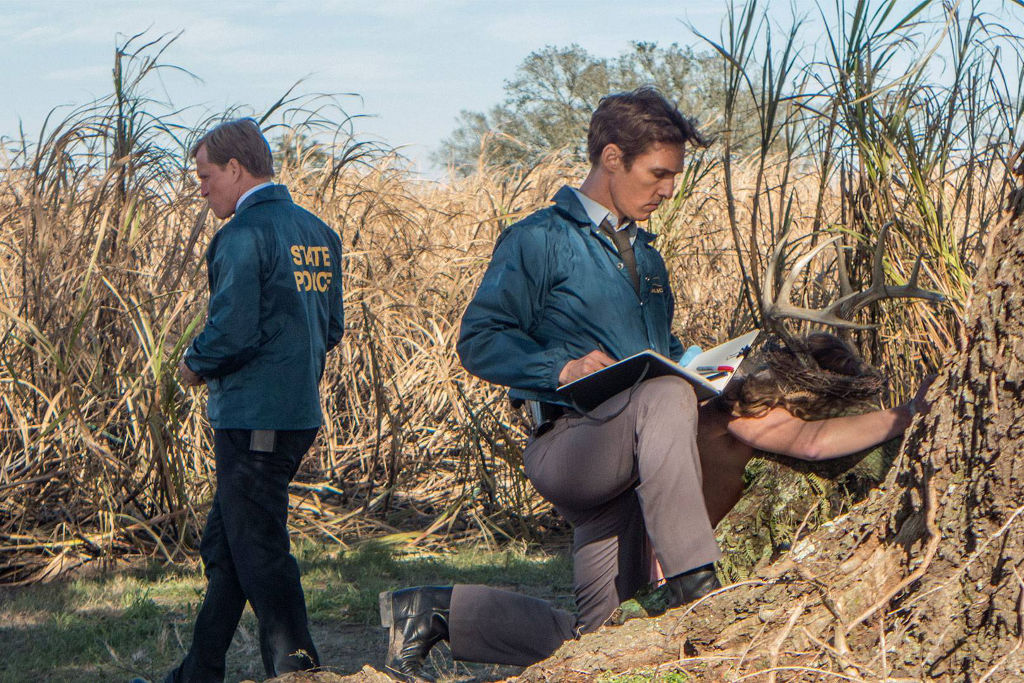
Let us speculate wildly, everyone! Please put on your tinfoil hats. The debut season of True Detective has finished, and some people are not happy about it! Admittedly not as not happy as many people were about how Lost ended, or Battlestar Galactica, or the Sopranos, but some people will never be happy.
There seems to be a lot of confusion about what actually happened at the end of season one, which I will happily clear up for you momentarily because I am right.
But first: what could Nic Pizzolatto have meant in that interview with HitFlix this week, when he said that season two of the show will explore “the secret occult history of the United States transportation system’”? Intrigue!
PART I: FROM HERE TO ETERNITY
Like another thoroughly excellent show that some cry babies like to dismiss, American Horror Story, True Detective is an anthology series. Goodbye, Hart and Cohle; hello whoever the next season’s detectives will be, and whichever location they will be solving their crimes in. Crimes apparently to do with the US transportation industry’s secret occult roots? OK!
Here are some ideas for season two material.
Exhibit A: America, what in crap is up with Denver International Airport?
Hmmm, nothing too unusual, as far as I can see.
This is the friendly horse of the apocalypse that actually greets travellers on arrival at the airport. At night its eyes glow a soothing shade of BLOOD RED.
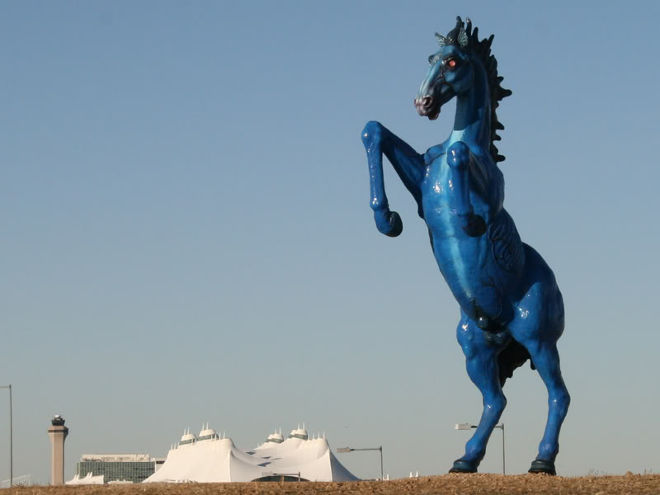
“Welcome, friends!”
Fun fact: the artist who created this was killed when the head of the horse fell on him and severed an artery in his leg. This is not a part of the conspiracy, just a thing that might happen if you try and make an effigy of a satanic horse, FYI.
Below is the equally-soothing triptych mural painted on the walls of the airport:
As you can see, it is a pretty run-of-the-mill, the-world-will-end-via-pestilence-unleashed-by-a-giant-Nazi-super-soldier-and-then-everyone-will-be-reborn-and-worship-a-psychedelic-plant-and-live-happily-ever-after story. NBD.
There are also some gargoyles sitting on suitcases and secret messages in the floor, and this time capsule buried by Free Masons, authorised by a New World Airport Commission that doesn’t actually exist. If you have any other questions just don’t ask them.
Now, perhaps you aren’t convinced. This is good! Skepticism is key to a good conspiracy theorist. So let me assure you of my bonafides: 00.01% of me likes to entertain the thought that Glenn Greenwald is actually a CIA stooge. That same part also likes to think that Satoshi Nakamoto is actually this NSA cryptologist, Tatsuaki Okamoto. I think this is healthy. Onward, comrades.
Exhibit B: The Cars That Ate America
So even if the second season doesn’t focus precisely on the world’s most sinister airport, perhaps Nic P is thinking about the General Motors streetcar conspiracy.
Eugh — boringly enough, this was an actual criminal conspiracy, and not the “we never went to the moon”, way more fun kind of conspiracy.
You might have noticed if you’ve ever tried to get around Los Angeles without a car that you can’t. Thanks a lot, General Motors! They did that on purpose by conspiring with a bunch of other auto industry companies to put the environmentally-friendly streetcars out of business in order to force everyone to buy a fancy new automobile. Law & Order: Transportation Unit certainly has a ring to it.
Exhibit C: The Man Who Wasn’t There
Let me tell you what else is a conspiracy: Nic Pizzolatto himself, that’s what!
Writers don’t look like this! Are you kidding me? This is what a casting agent thinks a writer looks like in Hollywood. He also seems to have come quite out of nowhere, no? With his mythic story of ‘just pitching a bunch of screenplays he wrote in a month’ or something, and then HBO buying about five of them, and then TA DA, Matthew McConaughey, and also I’m a novelist, and I DON’T THINK SO, “NIC PIZZOLATTO”.
If we are to take it on face value that Nic Pizzolatto is in fact a real person and not a gifted actor from an Abercrombie & Fitch catalogue constructed by producers to take the fall when season finales go bad then (and it’s a big if) fine, let’s also accept his word that “hard women” could feature as the two lead detectives on the next season.
Here are some ideas:
1. Daria And Jane
Yep.
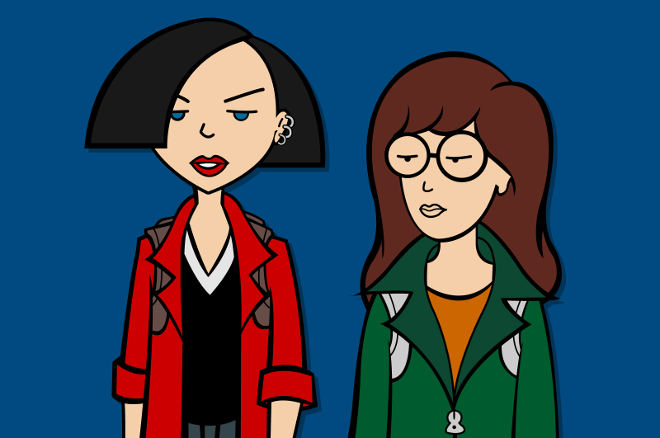
2. Thelma And Louise
Solving the mystery of where have they been in their flying car for the last 23 years.
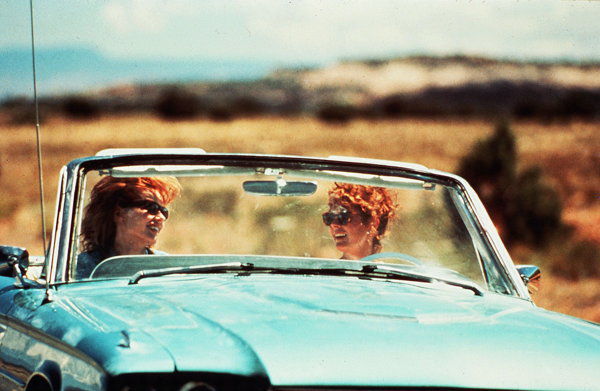
3. Leslie Knope and Ann Perkins
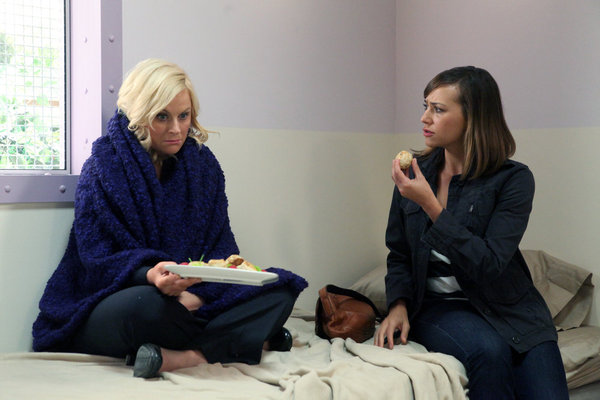
I really think Leslie has the chops for this:
(Okay, there are way funnier ideas for the roles here.)
–
PART II: ALL THE ANSWERS TO YOUR SEASON ONE QUESTIONS, WHICH I AM RIGHT ABOUT
Now that I have adequately proven to you why you should listen to me, here is what happened in season one:
What was the deal with the cult?
People are mad because at the end of the series, there wasn’t a huge reveal that showed the breadth of the cult conspiracy and had everyone from the top down apprehended. If you were paying attention though, that was the point.

Many times throughout the show we heard iterations of Rust’s assertion that, “This is a world where nothing is ever solved.” This came full circle in the last episode (see, time is a flat circle), when Marty said back to Rust, “We can’t get them all, it’s not that kind of world. We got ours.” This is a central tenet of weird fiction, which True Detective squarely put itself in the genre of with its illusions to the King in Yellow and Carcosa. The show was building on those mythos: the unknowable conspiracy casts a pall over everything, but is ultimately out of reach. By convention, it is revealed to the audience usually in a state of decay or disintegration, which is what we see with Errol being its last remaining member.
Errol was the son of Billy Lee Childress, the illegitimate son of Sam Tuttle – one of the original, fucked-up, paedophile patriarchs of the Tuttle/Childress clan, a sheriff who was also the father of Reverend Billy Lee Tuttle. Edwin Tuttle (who we never see, but who is eventually a Senator) is the Reverend’s cousin. Sheriff Ted Childress, who covers up Marie Fontenot’s disappearance, is another of Sam Tuttle’s illegitimate children. Billy Lee Childress is the man we see chained to the bed with his mouth sewn shut by Errol in his horror hut. At one point in the past, these people were all active in the sex/death cult – they are the masked men we see in the snuff video (or more thankfully, don’t really see). By the time of the 2012 showdown, the elder cult has been inactive since at least 1995 – with the exception of Errol, Reggie Ledoux and DeWall, who have been practising their own increasingly deranged, drug-enhanced version of the beliefs they were brought up with as members born into this horrifically screwed up family, bringing odd people in, like Dora Lange, who is later sacrificed.
Why did Errol leave the bodies out when everything else was kept so secret?
Because like with all serial killers, part of Errol wanted to be caught. We see through his scary ability as a mimic that he is very, very smart. Which is why he is so terrifying. By the time of the 1995 Dora Lange murder, the cult is already waning, leaving Errol to branch out on his own. Sam Tuttle is dead, and the Tuttle sons are climbing the ranks of legitimate state power. As there are no birth records for Errol, tying him to the larger family conspiracy would be difficult, up until they find Sam Childress’ body. By the 2012 timeline, and probably before, Errol is acting out of revenge for what was done to him by his father and the other cult actors. “You know what they did to me?” he taunts Rust in the chase through Carcosa. “What I would do to all the sons and daughters of man.” Errol was a monster made by other men.
Why did Reggie and Errol both call Rust “a little priest”?
It’s strongly intimated that in the Errol version of the cult’s belief system, death is not the end, and that death is welcomed; that possibly, the adult victims of the cult were willing sacrifices, and dying enabled an ‘ascension’ to their higher realm, where they escape the infinite time-loop of repeat existence on Earth.
Rust says something similar to this early on when looking at the eyes of the victims in crime scene photos, saying that in that last second “they let go and welcomed death”. When Reggie Ledoux says, “I know what happens next. I’ve seen you in my dreams,” he says this because, in their belief system, the person who kills you is a priest sent to free you from mortal existence. (This is likely their self-justification for the murders they commit.)
Errol calls Rust “a little priest” in the Carcosa catacombs because he also knows he has come to kill him. At the moment when Errol stabs Rust (in the side, like Christ) he growls at him, “Take off your mask!” This directly references The King In Yellow, the fictional play in the horror stories of Robert W. Chambers that drives anyone who reads it mad:
Camilla: You, sir, should unmask.
Stranger: Indeed?
Cassilda: Indeed it’s time. We have all laid aside disguise but you.
Stranger: I wear no mask.
Camilla: (Terrified, aside to Cassilda.) No mask? No mask!
Why does mostly everyone get away?
They don’t – and they do. Rust mails out his dossier of 17 years’ worth of evidence to every local and national law enforcement agency and every media outlet he can think of, so it’s safe for us to assume that other people’s work will unearth the full breadth of the cult conspiracy. Reggie Ledoux, DeWall, Errol, Billy Lee Childress, Sam Childress, Reverend Tuttle, are all dead. However, Edwin Tuttle, as we hear on the newscast while Rust Jesus watches from his hospital bed, gets away.
This reinforces another of the repeat themes of the series, that of the endemic corruption of (particularly male) power. This can’t be disunited from human nature: there will always be bad people, who the other “bad men” will have to keep from the door. This is also how more seasons of True Detective — and any story about light vs dark, which is nearly every story, can continue in its duality. Because time is a flat circle we are all doomed to forever repeat. Until we die. Maybe. Or not.
Speaking of that stuff, why did Rust get religion at the end?
He didn’t. For me, the end of True Detective affirmed nihilism, it didn’t refute it. Nihilism asserts that life has no meaning beyond that which we ascribe to it.

Nietzsche’s notion of infinite recurrence which Cohle refers to — time is a flat circle where everything that has ever or will ever happen repeats endlessly — is a thought experiment, not a literal belief in the endless loop of time on Earth (this is the samsara concept of Buddhism: life is a ceaseless, repeating cycle of suffering from which we are trying to escape by attaining Nirvana). The experiment asks you to try and live your life as if you are stuck endlessly repeating it, forever. If you were, would you choose more active agency over your actions? How would you live your best life, how would you try to change? How would you create meaning?
In the end, Rust decides to believe the light is winning, even though all the proof he has of the material world shows him this is not the case. So in the end, he chooses the wilful delusion of hope over the reality of life: his daughter being dead; the ultimate bad guys at the top of the cult getting away; the inevitability of more bad guys for him to bring down. It is really not the shiny happy ending a lot of people see it as, although you can of course see it that way, which is the beauty of the story. True Detective was itself a story about stories; it was about archetypes. More than anything, it was about systems of belief and conceptions of the self.
Did Rust hallucinate the swirling star vortex thing, or what was thaaaaaaaaaaat?
He either saw something mystical, or had a very badly-timed hallucination — whatever your own beliefs bring to the table.
All that stuff Rust said was just pretentious twaddle.
You could say that, or you could do your own reading and find out that’s not the case.
Wasn’t it horribly misogynist though?
No.

What? The New Yorker said it was!
The show was not misogynist – its characters were. The characters in the show, particularly Marty and obviously the cult members, were monsters. Hart was a monster in plain sight: a philandering, rage-filled hypocrite who rightfully lost his family for acting in ways that no decent human being should.
If you’re referring to the cult’s treatment of women, to call this misogynist is frankly stupid: they were a child-killing sex abuse ring that also murdered women. Yes, I would say that is misogyny right there, you true detective, you! These people definitely hate women! That was the entire point: the story indicted those behaviours.
The depiction of depraved acts is not a condoning of those acts; it is depicting some horrible, true parts of life. We really would love those parts to not exist — which, as per the underlying point of the show, will never, ever happen because some people are monstrous by nature.
Also note that Hart was punished for his actions: he is not a Walter White or Don Draper lead male character who constantly skirts his moral comeuppance and is for some reason venerated as a hero. Hart lost his family. He lives a lone, pathetic life in the 2012 timeline, with nothing but a fractious professional relationship with a self-involved nihilist to keep him going. It takes him nearly losing his life to take true stock of everything he has lost – which he is certainly not getting back, at least as far as reconciling with Maggie goes; she’s long over that shit. Perhaps he can salvage a relationship with his daughters, we don’t find out. It was testament to Harrelson’s performance that it was possible to feel a twinge of sympathy for such a vile character, who managed, however improbably, to achieve a modicum of change.
Season one of True Detective was a character study of two men. All the other characters, male or female, no matter how fleetingly vivid, were secondary to telling that story. They came across sometimes as props because that is what they were. You can see that as convenient or you can see it as deliberate, as ultimately the show was a procedural that very deliberately played self-aware games with that genre.
Procedural? Why don’t they cast Vincent D’Onofrio in this thing?
I don’t know genius, but they totally should! Haven’t you learned anything from turning down a role in The Sopranos, Vincent D’Onofrio?

I can’t wait for the next season!
Me neither.
Wait, who was The Yellow King?
This guy:

–
Elmo Keep has a website you can read if you like.

